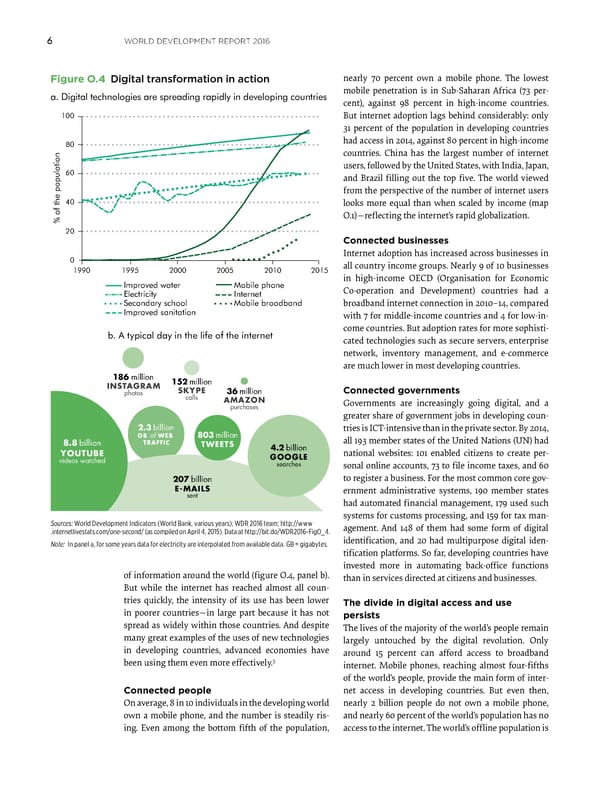WORLD DEVELOPMENT REPORT 2016 6 Figure O.4 Digital transformation in action nearly 70 percent own a mobile phone. The lowest a. Digital technologies are spreading rapidly in developing countries mobile penetration is in Sub-Saharan Africa (73 per- cent), against 98 percent in high-income countries. 100 But internet adoption lags behind considerably: only 31 percent of the population in developing countries 80 had access in 2014, against 80 percent in high-income countries. China has the largest number of internet users, followed by the United States, with India, Japan, 60 and Brazil filling out the top five. The world viewed from the perspective of the number of internet users 40 looks more equal than when scaled by income (map % of the population O.1)—reflecting the internet’s rapid globalization. 20 Connected businesses 0 Internet adoption has increased across businesses in 1990 1995 2000 2005 2010 2015 all country income groups. Nearly 9 of 10 businesses Improved water Mobile phone in high-income OECD (Organisation for Economic Electricity Internet Co-operation and Development) countries had a Secondary school Mobile broadband broadband internet connection in 2010–14, compared Improved sanitation with 7 for middle-income countries and 4 for low-in- b. A typical day in the life of the internet come countries. But adoption rates for more sophisti- cated technologies such as secure servers, enterprise network, inventory management, and e-commerce are much lower in most developing countries. 186 million 152 million INSTAGRAM SKYPE 36 million Connected governments photos calls AMAZON purchases Governments are increasingly going digital, and a greater share of government jobs in developing coun- 2.3 billion 803 million tries is ICT-intensive than in the private sector. By 2014, GB of WEB all 193 member states of the United Nations (UN) had 8.8 billion TRAFFIC TWEETS 4.2 billion YOUTUBE GOOGLE national websites: 101 enabled citizens to create per- videos watched searches sonal online accounts, 73 to file income taxes, and 60 207 billion to register a business. For the most common core gov- E-MAILS ernment administrative systems, 190 member states sent had automated financial management, 179 used such systems for customs processing, and 159 for tax man- Sources: World Development Indicators (World Bank, various years); WDR 2016 team; http://www agement. And 148 of them had some form of digital .internetlivestats.com/one-second/ (as compiled on April 4, 2015). Data at http://bit.do/WDR2016-FigO_4. Note: In panel a, for some years data for electricity are interpolated from available data. GB = gigabytes. identification, and 20 had multipurpose digital iden- tification platforms. So far, developing countries have invested more in automating back-office functions of information around the world (figure O.4, panel b). than in services directed at citizens and businesses. But while the internet has reached almost all coun- tries quickly, the intensity of its use has been lower The divide in digital access and use in poorer countries—in large part because it has not persists spread as widely within those countries. And despite The lives of the majority of the world’s people remain many great examples of the uses of new technologies largely untouched by the digital revolution. Only in developing countries, advanced economies have around 15 percent can afford access to broadband been using them even more effectively.5 internet. Mobile phones, reaching almost four-fifths of the world’s people, provide the main form of inter- Connected people net access in developing countries. But even then, On average, 8 in 10 individuals in the developing world nearly 2 billion people do not own a mobile phone, own a mobile phone, and the number is steadily ris- and nearly 60 percent of the world’s population has no ing. Even among the bottom fifth of the population, access to the internet. The world’s offline population is
 World Development Report 2016 Page 16 Page 18
World Development Report 2016 Page 16 Page 18